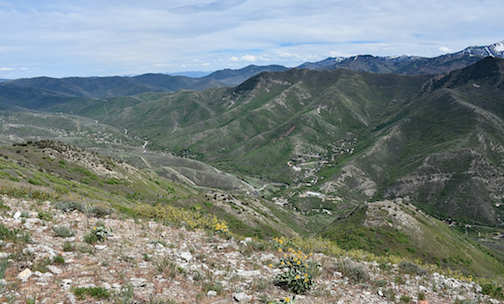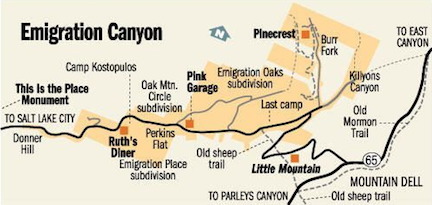Emigration Canyon
The long, westward trek of the Pioneers, from the banks of the Mississippi River to the Salt Lake Valley, culminated with a journey through Emigration Canyon in the Wasatch Mountains.
When the pioneers emigrated to Salt Lake City, they traveled through Echo Canyon, into East Canyon, then down Emigration Canyon. When Brigham Young reached the top of Big Mountain in East Canyon, where the trailhead begins, it is here on July 23, 1947, that he looked across the valley and declared "This is the right place ... carry on!'"
A monument at Big Mountain reads:
- On 19 July 1847, scouts Orson Pratt and John Brown climbed the mountain and became the first Latter-Day Saints to see the Salt Lake Valley. Due to illness, the pioneer camp had divided into three smaller companies. On 23 July, the last party, led by Brigham Young, reached the Big Mountain. By this time most of the first companies were already in the valley and planting crops. Mormons were not the first immigrant group to use this route into the Salt Lake Valley. The ill-fated Donner Party blazed the original trail one year earlier. They spent thirteen days cutting the trail from present-day Henefer into the valley. That delay proved disastrous later on when the party was caught in a severe winter storm in the Sierra Nevada Mountains. The Mormons traveled the same distance in only six days. Until 1861, this trail was also the route of California gold seekers, Overland Stage, Pony Express, original telegraph line, and other Mormon immigrant companies, after which Parley's Canyon was used.
“Pratt’s words capture the grandeur of that moment, “After issuing from the mountains . . . and beholding, in a moment, such an extensive scenery open before us, we could not refrain from a shout of joy . . . the grand and lovely scenery was in our view.”[1]
Emigration Canyon is a 9-mile-long, 2-mile-wide stretch of forest, brushy hillside and canyon bottom east of Salt Lake City. As a canyon, "Emigration Canyon’s history is ancient, and important to Native Americans, as well early Utah settlers and emigrants bound for California." The travelers were steady and included scouts, emigrants, Pony Express riders, teamsters, and those with dreams of striking gold in California.[2]
The completion of the transcontinental railroad in 1869 began to slow the stream of travelers down the canyon and the place morphed into a place to build a home and live. “Many of the homes were DIY projects. The area was seen as so out of the way that it was difficult to get a home loan from the banks, who reportedly found it risky to loan to such a ‘depressed area.’”[3] Among its inhabitants are wealthy professionals, working families, and “colorful characters”—many of whom are not members of The Church of Jesus Christ of Latter-day Saints.[4] The canyon is a popular route for bicyclists, motorcyclists, and runners.
“President Calvin Coolidge considered it for a summer White House. One of the largest breweries west of the Mississippi River sat at the canyon mouth. An electric railroad once ran top to bottom. LDS Church President Heber J. Grant conducted ecclesiastical business from his family cabin.”[5]
Travelers today motor along paved roads, marveling that the Pioneers and other emigrants could pass along the mountains and periodic meadows of these canyons, following rocky paths that dipped and rose along the mountains. The road is sometimes steep and feels enclosed, especially toward the end while in Emigration Canyon. Historical markers are found along the journey.
In 2003, residents Jeff Carlstrom and Cindy Furse captured the canyon's past in a book titled The History of Emigration Canyon — Gateway to Salt Lake Valley. The nearly 300-page volume tells the canyon story from pre-1845.

